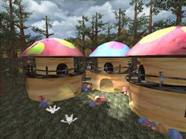 |
The objective was to test use of a custom-designed VR environment’s effectiveness in distracting from the pain of dental procedures. No VR pain distraction product customized to dental practice currently exists. The Phase III product, a fully integrated VR and physiological monitoring device for use in general dental practice, will consist of virtual environment software, compatible computer hardware, a head-mounted display (HMD), physiological sensors, a physiological sensor interface module, and a wireless peripheral device used to interact with and explore the virtual world. The system is designed to be inexpensive, easy to use, upgradeable, and reliable. Analysis of human factors is focusing on the unique aspects of care delivery in the modern dental suite.
VRMC placed another of its pain distraction virtual environments for testing at Naval Medical Center San Diego (NMCSD), where a culturally diverse population suffers from chronic pain from disorders such as fibromyalgia, lower back pain, migraine, and temporomandibular joint dysfunction. NMCSD also treats active duty military returning from Operation Iraqi Freedom who have shrapnel and burn wounds and are experiencing acute pain. The NMCSD clinical study found that this virtual environment, navigated using an HMD, dramatically reduced pain ratings by over 75 percent. Physiological data collected from this same population corroborated this discovery and suggests that participants experienced less anxiety while engaged in the virtual world.
Because of its work with NIH, VRMC is required to be certified by the U.S. Office of Public Health and Science, Office of Research Integrity. All VRMC research staff possess certificates of completion for the HHS Office of Human Research Protections Human Subject Assurance Training, and the National Cancer Institute’s Human Participant Protections Education for Research Teams.
In 2005, Dr. Mark Wiederhold won the opportunity to showcase the “Dental II Results” poster presentation at the 7th Annual NIH SBIR/STTR Conference, July 28-29, in Washington, DC. Next, VRMC won 1 year of commercialization support for its pain management products from the National Institutes of Health Commercialization Assistance Program NIH-CAP), beginning September 2005. In October 2006, VRMC was invited to speak about its experience in this program at the NIH-CAP Commercialization Training Workshop. Finally, VRMC was invited to exhibit its pain and PTSD products at the California Early Stage Medical Device Company Showcase, part of the California Medical Device Forum held November 1-2 in Irvine.
VRMC’s dental product was featured in the peer-reviewed journal Pain Medicine (Wiederhold, M.D., & Wiederhold, B.K. (2007). Virtual reality and interactive simulation for pain distraction. Pain Medicine, 8(S3), S182–S188).
![]()